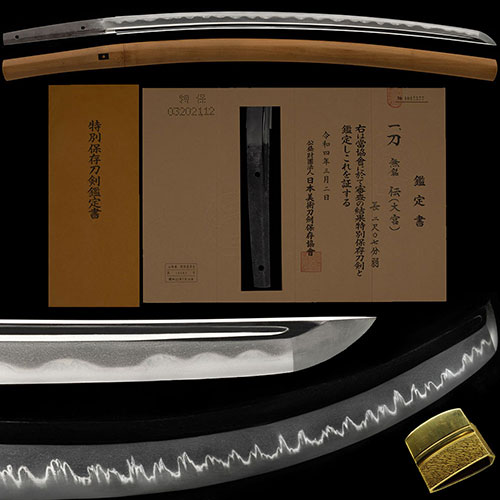
特別保存刀剣Tokubetsuhozon Token
大宮 刀 Ohmiya Katana
No.305191刀 大宮 盛景 南北朝貞治頃 約660年前 華やかな互の目丁子匂口明るい優品 二尺七分Katana Ohmiya Morikage Nanbokucho period Around Teiji About 660 years ago Gorgeouse Gunome-Chouji Nioikuchi is bright a good works 62.7cm
商談中Hold
- 極めKiwame
- 大宮Ohmiya
- 登録証Registration
- 山形県 Yamagata 昭和32年7月18日 7/18/32(Showa)
- 時代Period
- 南北朝時代Nanbokucho Era
- 法量Size
-
刃長 62.7cm (ニ尺七分) 反り 1.7cm
元幅 3.0cm 先幅 2.0cm 元重 0.62cm 鎬厚 0.77cm 先重 0.57cm 鋒長 3.1cm 茎長 18.7cm 重量 703gHachou 62.7cm (ニ尺七分) Sori 1.7cm
Moto-Haba 3.0cm Saki-Haba 2.0cm Moto-Kasane 0.62cm Shinogi-Thikess 0.77cm Saki-Kasane 0.57cm Kissaki-Chou 3.1cm Nakago-Chou 18.7cm Weight 703g - 国Country
- 備州Bisyu
- 姿Shape
- 鎬造、庵棟、身幅広く、反りやや深く、腰反り付き、中鋒。Shinogidukuri, Iorimune, Wide Mihaba, Slightly deep Sori, Koshizori-tsuki, Chu-Kissaki
- 鍛Kitae
- 板目肌に、杢目肌交じり、地沸微塵に厚くつき、地景よく入り、肌立ち、淡く映りたつ。Itamehada, Mixed Mokume-hada, Jinie entered fine and thick, Chikei entered well, Hadatachi, Faintly Utsuri-tatsu.
- 刃文Hamon
- 焼き幅大きく、腰の開いた互の目・箱形の刃・丁子刃・重花風の丁子・など交じり、足よく入り、小沸よくつき、沸筋・砂流し掛り、匂口明るい。Big Yakihaba, Koshino-hiraita-Gunome,Box-shaped blades,Chouji-ba、Juka-style Chouji and mixed etc... There are many Ashi and Small-Nie entered well, Niesuji and Sunagashi-kakari, Nioikuchi is bright.
- 帽子Boushi
- 乱れ込んで小丸。Midarekonde-Komaru
- 茎Nakago
- 大磨上、先切、鑢目浅い勝手下り、目釘孔二。Oh-Suriage
- ハバキHabaki
- 金着一重。Gold-clad single layer
- 説明Drscription
- 備前大宮派は、同派の遠祖国盛が、山城国猪熊大宮より移住したことに始まると伝え、「備州長船盛景」などと長銘に切る盛景がその代表工とされてきたが、近年、その作風や逆鏨に切る銘字の共通性より、同工は近景・義景の系譜に連なる長船傍系の鍛冶で、むしろ「盛景」・「盛継」などと二字に大振りにきる鍛冶こそが、国盛の流れを汲む真の意味での大宮鍛冶ではないかとする新説が生まれ、従来の説に検討を促している。長船盛景の作域は広く、のたれを主調とするもの、丁子や互の目が交る変化のある華やかな乱れ刃、角互の目を主調とするもの、青江風の直刃など多彩である。この刀は、板目に杢目交じり、地沸微塵に厚くつき、地景よく入り、淡く映りがたつ地鉄に、互の目に、箱形の刃・丁子・重花風の丁子・など交え変化に富み、焼き幅大きな華やかな刃を焼き、沸筋・砂流し掛かるなど相伝備前の特色を示し、兼光に比して野趣を感じさせる盛景の見どころをよく示した優品である。The Bizen Omiya school is said to have started when the distant ancestor Kunimori of the same school emigrated from Yamashiro Province Inokuma Omiya, and Morikage, who cuts a long inscription such as 'Bishu Osafune Morikage', has been regarded as the representative craftsman. In recent years, due to the commonality of the style and the inscription that cuts in reverse, the blacksmith is a branch of Osafune, which is in line with the genealogy of Yoshikage and Yoshikage. A new theory has arisen that blacksmithing is truly Omiya blacksmithing that follows the flow of Kunimori, prompting an examination of the existing theory.
Morikage Osafune covers a wide area, with Notare as the main theme. Mixed Chouji and Gunome a variously gorgeous Midare-ba, There are a variety of works, such as those based on KakuGunome and Aoe-style Suguha.
This sword has a Mokume mixed in Itame, Jinie entered fine and thick, Chikei entered well, Faintly Utsuritatsu Jigane, Gunome, Box-shaped blades, Chouji, mixed Juke-style Chouji etc.. It is an excellent product that shows the characteristics of Soden-Bizen, such as the gorgeous Big Yakihaba, Niesuji and Sunagashi-kakaru.This is an excellent piece that shows the highlights of Morikage, which is more rustic than Kanemitsu.





